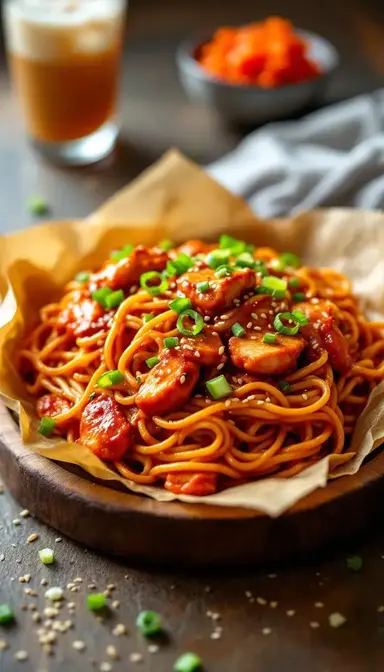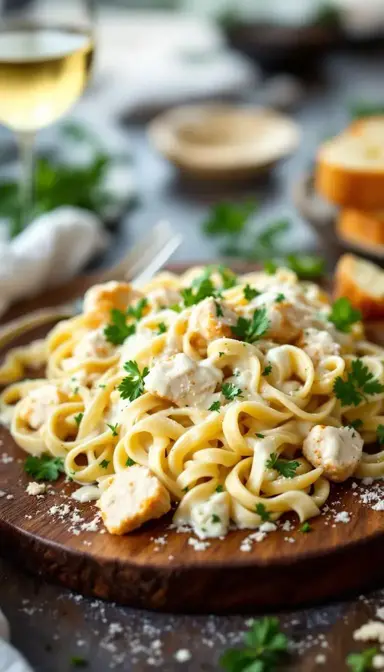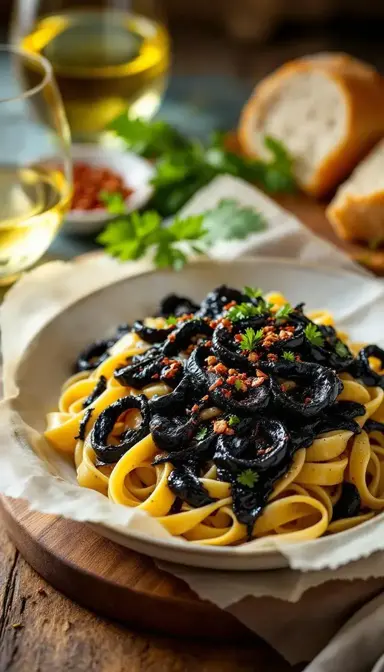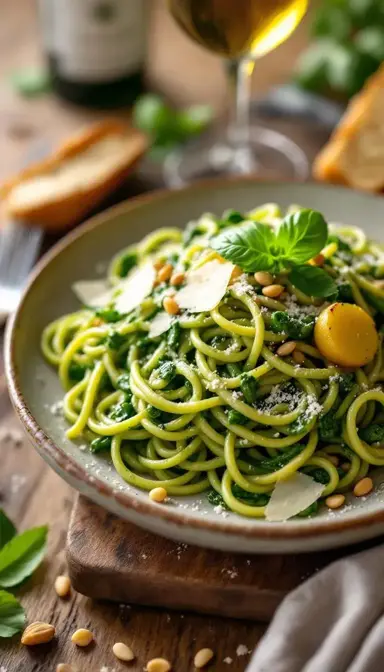Let me tell you about the kind of dish that makes you cancel your takeout order mid-click. These Saucy Gochujang Noodles with Chicken are what happens when Korean spice meets weeknight convenience—a glorious tangle of chewy noodles and juicy chicken swimming in a sauce that’ll have you licking the bowl. I first fell for gochujang’s magic during a rainy Seoul evening when a street vendor handed me a steaming cup of tteokbokki. That addictive balance of sweet heat and deep umami? We’re bottling that lightning here in under 30 minutes.
Why This Recipe Works
- Weeknight warrior: Faster than delivery, with none of the guilt (or mystery meat).
- Flavor fireworks: Gochujang’s fermented complexity gets balanced by honey’s sweetness and soy’s saltiness—like a perfectly tuned orchestra in your mouth.
- Protein playground: Chicken thighs stay juicy, but shrimp or tofu work just as hard here.
The Story Behind the Sauce
That crimson paste in your fridge? It’s Korea’s centuries-old secret weapon—fermented chilies, rice, and soybeans working together like old friends. I keep a tub next to my stove the way Italians guard their parmesan.
Essential Ingredients & Tools
The Marinade (Where the Magic Starts)
- 1 lb chicken thighs: Skinless, boneless, sliced like you mean it—against the grain for tenderness that’ll make you weep.
- 1 tbsp soy sauce: The salty backbone of our flavor building.
- 1 tsp toasted sesame oil: That nutty aroma that says “authentic” without trying.
The Sauce (The Star of the Show)
- 3 tbsp gochujang paste: Start here, adjust later—brands vary wildly in heat.
- 2 tbsp soy sauce: Because depth matters.
- 2 tbsp honey: Nature’s perfect sweet-tamer for spice.
- 1 tbsp rice vinegar: The subtle tang that keeps things interesting.
- 1 tsp sesame oil: Round two, because why not?
- ½ cup chicken broth: Your sauce’s liquid lifeline.
The Supporting Cast
- 10 oz udon noodles: Thick, chewy, and sauce-hugging. Soba works in a pinch.
- 3 garlic cloves: Minced, not pressed—we want texture, not bitterness.
- 1 tbsp fresh ginger: Grated like you’re zesting life itself.
- 2 green onions: Whites for cooking, greens for that fresh pop at the end.
- 1 tbsp neutral oil: Chicken needs a proper sear, not a steam bath.
- 1 tbsp cornstarch + 1 tbsp water: Your ticket to glossy, clingy sauce perfection.
- sesame seeds: For garnish (optional).
Tools You’ll Need
- A wok (or your trustiest skillet)
- A pot that’s seen its share of pasta battles
- One sharp knife—dull blades are the enemy of quick dinners
Serves 4 hungry humans | Active time: 25 minutes (because who’s counting?)
How to Make Saucy Gochujang Noodles with Chicken
- Chicken Prep: Slice 1 lb chicken thighs against the grain—imagine you’re cutting tiny speed bumps so each bite melts effortlessly. A quick 1 tbsp soy sauce and 1 tsp toasted sesame oil bath (5 minutes max) is all they need. Why? Cutting against the grain shortens muscle fibers for tender bites, while the marinade jumpstarts flavor penetration.
- Sauce Alchemy: Whisk together 3 tbsp gochujang paste, 2 tbsp soy sauce, 2 tbsp honey, 1 tbsp rice vinegar, 1 tsp sesame oil, and ½ cup chicken broth. Taste it raw—it should punch you slightly harder than you’d like (noodles will soften the blow). Pro move: Dissolve honey in warm broth first to avoid graininess.
- Noodle Zen: Cook 10 oz udon noodles just shy of done—they’ll finish in the sauce. Save that starchy pasta water like it’s liquid gold (because it is). Why? Undercooking prevents mushiness, and pasta water’s starch helps sauce cling.
- Chicken Drama: Hot pan, 1 tbsp neutral oil, single-layer chicken. Listen for that sizzle—no steaming allowed. We want golden edges with juicy centers. Set aside; they’ll reunite with the sauce soon. Why? Crowding the pan lowers the temperature, causing steaming instead of browning.
- Aromatic Awakening: Sauté 3 minced garlic cloves, 1 tbsp grated ginger, and whites of 2 green onions for 30 seconds max before they go from fragrant to tragic. Why? High heat quickly releases oils without burning.
- Sauce Transformation: Pour in your sauce, scraping up those browned bits (aka free flavor). Add 1 tbsp cornstarch + 1 tbsp water slurry and watch it thicken into glossy perfection—about 2 minutes of patient stirring. Why? Simmering activates cornstarch’s thickening power.
- The Grand Reunion: Add 10 oz cooked udon noodles and chicken back in. Toss like you’re dressing a salad—gently but thoroughly. Too thick? Pasta water to the rescue, one tablespoon at a time.
- Final Flourish: Garnish with greens of 2 green onions and sesame seeds—because we eat with our eyes first.
Pro Technique
Spice Control
Gochujang heat sneaks up like a ninja. Too intense? A drizzle of honey cools the burn. Too tame? A pinch of gochugaru (Korean chili flakes) brings the fire.
Slurry Science
Cornstarch and water should be equal parts—whisk until it’s smoother than a jazz solo. Add to simmering sauce while stirring like your dinner depends on it (because it does).
Storage & Freshness Guide
Fridge
3 days max—reheat with a splash of water to revive the sauce’s silkiness.
Freezer
Skip the noodles; freeze sauce and chicken for future quick meals. Thaw, cook fresh noodles, and pretend you’re a meal prep guru.
Ingredient Variations and Their Impact
Protein Roulette
- Shrimp: 2 minutes per side—any longer and they’ll turn to rubber.
- Tofu: Press, cube, and fry until golden. Bonus: Marinate it in the sauce first.
- Pork: Thin slices of shoulder—rich enough to stand up to the sauce.
Noodle Notes
Soba brings nuttiness; rice noodles go gluten-free. Just adjust cooking times accordingly.
Perfect Pairings
Complementary Dishes
- Kimchi Cucumber Salad: The cool crunch and tangy bite cut through the dish’s richness. Thinly slice cucumbers, toss with kimchi juice, and finish with sesame seeds.
- Steamed Egg Custard (Gyeran-jjim): Silky, mild, and protein-packed—this Korean classic balances the heat.
Drinks
- Iced Barley Tea: Toasty and caffeine-free, it’s Korea’s answer to Iced Tea.
- Crisp Lager: The bubbles and mild bitterness reset your palate between bites.
Something Sweet
- Honey-Drizzled Asian Pear: Juicy slices with honey soothe the spice.
- Matcha Ice Cream: Earthy sweetness and cool creaminess are the perfect finale.
FAQs
“My sauce is too thick!”
A splash of broth or water fixes everything. Adjust seasoning after thinning.
“Can I use gochujang sauce?”
Stick to paste—sauces are often diluted and sweetened beyond recognition.
“Help, it’s too spicy!”
A dollop of yogurt or extra honey will save your palate.

Saucy Gochujang Noodles with Chicken: A Fiery, Flavor-Packed Weeknight Savior
Whip up Saucy Gochujang Noodles with Chicken in under 30 minutes! Spicy, sweet, and packed with flavor—perfect for weeknight dinners. Get the recipe now!
Ingredients
For the Marinade
-
1 lb boneless, skinless chicken thighs
-
1 tbsp soy sauce
-
1 tsp toasted sesame oil
For the Sauce
-
3 tbsp gochujang paste
-
2 tbsp soy sauce
-
2 tbsp honey
-
1 tbsp rice vinegar
-
1 tsp toasted sesame oil
-
½ cup chicken broth
For the Main Dish
-
10 oz udon noodles
-
3 cloves garlic
-
1 tbsp fresh ginger
-
2 green onions
-
1 tbsp neutral oil
-
1 tbsp cornstarch
-
1 tbsp water
Instructions
-
Slice chicken against the grain, marinate with soy sauce and sesame oil.01
-
Whisk sauce ingredients (except cornstarch and water).02
-
Cook noodles al dente, reserve ¼ cup pasta water.03
-
Sear chicken in hot oil until golden, set aside.04
-
Sauté garlic, ginger, and onion whites for 30 seconds.05
-
Add sauce, simmer, then stir in cornstarch slurry to thicken.06
-
Toss in noodles and chicken, adjust consistency with pasta water.07
-
Garnish with green onions and sesame seeds.08



